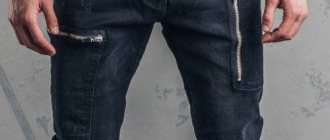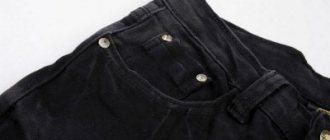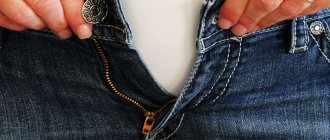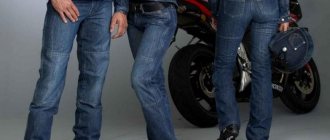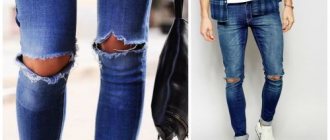Know the enemy by sight
It is much easier to monitor the condition of your jeans than to try to sew up rags on the loin. For example, look at the photo below.
There are two problems here:
- The seam begins to unravel.
- Jeans are frayed between the legs.
What to do with such problems? First, you need to fix the bad seam. Otherwise, you may have a very awkward moment when your pants crack. This can be done manually or by machine. Sewing stores sell special strong threads for sewing denim, which are dyed in popular colors for stitching on denim.
Secondly, you need to carefully mend those areas where the thread has worn out. To do this, select threads that not only match the color of the fabric, but have the same thickness.
Straighten the fabric and, being sure to secure stitches in areas that are still tight, begin making horizontal stitches over the hole. Insert a needle into the opposite edge of the tear. Then make a vertical stitch downwards and only then go back. This is necessary so that the threads do not squint or pull the fabric.
Having completed the horizontal row, start working on the vertical row, passing the needle between the threads. Essentially, you will be weaving new fabric over the old one.
Why it rubs between the legs when walking: causes and prevention
Hello, dear readers of our blog. Rubbing between the legs when walking is a rather delicate problem that is known not only to women, but also to men. Many of you know about it firsthand. This problem becomes especially relevant during the summer heat, when increased sweating only aggravates the situation. In this article, we will analyze in detail the causes of chafing, as well as ways to eliminate it and what preventive measures will be effective.
Why does it rub between my legs?
Many ladies are embarrassed by this problem, since it most often occurs in overweight people. Full legs, or rather thighs, rub against each other while walking, resulting in irritation, sores and even ulcers. In the heat, the skin sweats, and accordingly, it rubs between the legs even faster.
It is worth noting that this problem is familiar not only to overweight people, but also to women with peculiarities of the anatomical structure of their legs. Also, abrasions between the legs can appear during pregnancy if a woman suffers from edema.
On the beach, such women are immediately visible; they bashfully cover their hips with a pareo, not because they are embarrassed by their full legs or cellulite on their hips, but because the area of friction is different in color from the rest of the skin. It has a gray or brown tint.
Repair for impending damage
This method can be used for minor damage. For example, there is no hole yet, but the jeans are already frayed between the legs. What to do? It is necessary to strengthen the tissue as soon as possible. To do this, you will need denim patches, fabric glue or hot-melt adhesive tape (“gossamer”).
Cover the area with bad fabric with tape, place a piece of denim on top and iron with a heated iron. This patch is invisible, completely merges with the base, the glue penetrates the structure of the fabric and strengthens it. If you have a high-quality “spider web”, it will last a long time. The frequency of washing also affects its service life. Of course, if you additionally sew the area of the patch, it will last as long as you wear these jeans.
If you're lucky, you can find ready-made patches in sewing stores. They have one side made of denim, the other - hot glue. They are also attached to the fabric using an iron.
But this method has a drawback - the patches should be small, since the fabric becomes harder, creases worse and can cause discomfort if such an area occupies a large area.
The jeans were frayed between my legs. What to do?
The photo below reflects a picture familiar to many.
It would seem that this pair can be safely thrown into the trash. What to do if your jeans are frayed between your legs, how to sew up large holes discreetly and neatly?
There are two ways:
- Machine darning. Manually this will be a long and painstaking process, while a special machine will mend such a hole in 5 minutes. See before and after photos.
The machine literally recreated the structure of the fabric and strengthened the edges of the hole.
Of course, you will have to contact a sewing studio, and the sooner, the better the repair will be.
- Applying fabric patches. This is a more budget-friendly method, since you can do it yourself (if you have a machine) or ask your friends.
How to sew a patch
So, your jeans are frayed between your legs. What to do if the hole is big?
1. Trim any loose threads at the edges without touching the fabric itself.
2. Turn the jeans inside out and trace the hole, 2.5 cm from the edge. Ideally, the edges of the hole should be overlocked, but then the patch will be more noticeable.
3. Cut the “webs” or adhesive interlining to the required area. Do the same with denim for repair. It is better to cut it diagonally from the interweaving of threads. This way the fabric will not fray or unravel. Or use ready-made patches.
4. Glue the interlining and denim to the hole using a preheated iron. Lightly steam the patch, paying special attention to its edges. Wait for the area to cool down.
5. Then sew the edges of the patch using a sewing machine.
Turn the jeans inside out and sew new fabric diagonally from the right side. A zigzag stitch is perfect for this purpose.
6. Hide the ends of the threads and the repair is complete.
If you notice that the seam joint between the legs is starting to fray, cover it with a patch, as shown in the following photo.
Paraffin treatment
Immediately after purchase, while the jeans are still new and clean, you should rub them with paraffin in problem areas, and it should be colorless. Particular attention should be paid to the seams. Paraffin is applied from the front side. If jeans are worn quite actively, then they should be treated in the same way at least once a week. If pellets begin to form in the problem area, they should be removed using nail scissors or a blade, but carefully so as not to get hurt.
What should you do to prevent your jeans from rubbing between your legs?
It is often easier to prevent a problem than to solve it. Protect your favorite jeans from disaster by caring for them and wearing them correctly to avoid premature wear on your inner legs.
If jeans are too tight or, on the contrary, too loose in the hips, then this leads to excessive friction, and in the future - to holes. Also, the lower the fit, the more stress there is on the fabric in the hip area and the more often the jeans fray between the legs. What to do to avoid this annoying phenomenon? Buy models that fit you and fit well. Of course, denim stretches, but everything has its limits, so judge your actual size wisely. Also check that there are no manufacturing defects or scuffs on the pair you are about to buy.
Lifehacks to help prevent scuff marks:
- When buying, choose the right size, you can take a looser one.
- Give preference to pants with a medium or high waist; they are less likely to wear out quickly.
- Fidget less in your chair.
- Wash your jeans properly: hand wash or delicate wash will do. They need to be turned inside out, fastened with a zipper and buttons, and not washed too often.
- At the first sign of scuffing, take it to a workshop or, if possible, fix the problem yourself.
- Buy several pairs of pants and wear them alternately, this way you will increase the service life.
- Try purchasing quality custom made jeans.
Proper washing
If you don't read the care label, you shouldn't complain about your jeans getting worn between your legs. What should I do to ensure that denim survives cleaning successfully?
Turn your jeans inside out and wash them separately or with two or three other pairs of jeans. There is no need to resort to this procedure unless necessary. But you shouldn’t neglect it either (not only due to obvious factors), because particles of dirt and dust act as small abrasives when moving, fraying the threads of the fabric.
Wash your jeans on a gentle cycle with cold or warm water, avoiding hot water or bleach, which weakens the denim.
Machine drying also causes jeans to fray between the legs. What to do to minimize harm after washing? Instead of throwing your pants in the dryer, it's better to hang them in the bathroom or on the balcony the old-fashioned way and wait patiently for them to dry.
Now you know what to do to prevent jeans from rubbing between your legs, and you can significantly extend their service life.
6Expert opinion
Experienced cutters believe that the reason for jeans fraying is the cut shortcomings of modern models. The wedge pattern for jeans should be made using an oblique thread. This allows the fabric to stretch as you move, allowing freedom of movement. But this sewing method involves a large number of fabric scraps. To make the sewing production process cheaper, the product is cut in a thread direction that does not involve stretching. As a result of constant stress, the fabric deteriorates very quickly.
An inexperienced buyer will not be able to identify the correct or incorrect cut of a product. Therefore, the ideal option would be to tailor jeans to order, which provides a long-term guarantee.
If none of the above methods help, then you will have to go to the store for a new pair of trousers. Old jeans can be saved for sewing useful things, such as potholders, potholders or bags, or for repairing clothes.
Sports and denim
The bicycle is the worst enemy of jeans. Frequent and monotonous up and down movements, accompanied by friction against the edge of the saddle, destroy the fabric very quickly. This is why cyclists constantly wear their jeans between their legs. What to do in this case? If you regularly ride in jeans, then you will have to come to terms with future holes and immediately put patches on problem areas. Better yet, get a pair of trousers designed for cycling. Moreover, these can also be jeans, but specially made for such use, for example, Levi's 505 Commuter or Cadence Raw Denim Jeans. They have double or padded fabric on the seat.
Sew patches onto problem areas
Another way to solve the problem of rubbing the product is to sew patches onto problem areas. For example, it could be old tights. It should be sewn on the inside, otherwise it will look extremely ugly, as you might guess. This will allow the product to last many times longer. When sewing on pieces of fabric, you should be careful and careful so that the seam on the front side is not noticeable. If you can’t do it yourself, then you can go to the nearest studio and ask them to do everything efficiently.
Nothing is eternal
If your jeans are frayed between your legs, you already know what to do with them. But there will come a time when you have to throw them away, no matter how hard you try to distance it.
True, the Dutchman Ari Vandenberg lovingly darned and patched his Levi's jeans for 8 years.
After this, they not only completely lost their resemblance to the original, but even attracted the attention of fashion publications and won a competition from a famous clothing store in Amsterdam. And for Ari, they became, to some extent, the embodiment of part of his life path. A fitting role for real jeans, isn't it?


